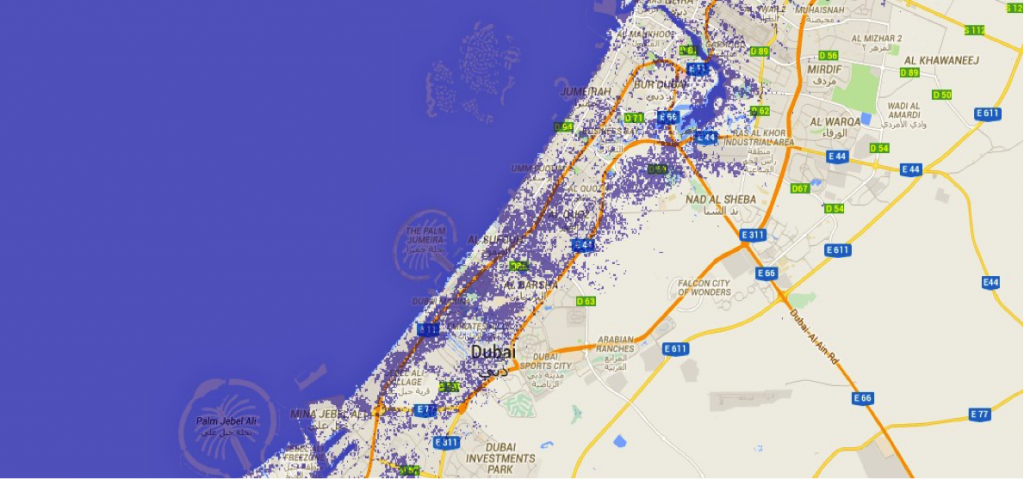 Source: flood.firetree.net
Source: flood.firetree.netDubai, UAE, is a coastal city in the Persian Gulf, with an arid, hot climate, and low precipitation. The city’s population is 2.24 million (Government of Dubai, 2014) and has been growing at 5 to 7% per year, by 2020 it is projected to reach 3.4 million (7 Day Dubai, 2014). Expatriates constitute 85% of its population, which resulted from decades of economic diversification away from oil production and into wholesale, real estate, financial services and tourism, which collectively make up around 62% of Dubai’s GDP (Gulf News, 2013). The real estate sector has expanded in the past decade, extending Dubai’s natural coastline by 166% (DeNino, 2012). There are further plans to add another 492 miles, which will add 1.5 million more inhabitants to the coastal area (The Emirates Network, 2007). Growing population and heavy development of these areas pose a challenge for the city government in terms of protecting the population, their properties, and coastal infrastructure from rising sea levels.
In addition to the risk of sea level rise, Dubai is vulnerable due to its limited fresh water supply. The principal desalination system, Jebel Ali, which provides majority of freshwater to the city is located a few feet above sea level. Desalination plants provide 98% of Dubai’s freshwater (Hackley, 2013) and have four days of fresh water supply in reserves (Alderman, 2010), making water access a national priority, particularly as average temperatures are projected to rise by 4.5 degrees in summer by 2100 (Dougherty et al, 2009). Water demand per capita is 132 gallons per day, which is 82% above global average (Emirates 24/7, 2013), and households account for 60% of demand. The combination of Dubai’s lmited freshwater supply and usage habits, as well as the hazard of sea level rise to the desalination facilities, we have recommended adaptation as a policy response. Dubai’s adaptive capacity is high, both in terms of its willingness and ability, which is demonstrated by its recent identification of sustainable growth as a major theme for the Dubai Expo 2020 (Sukkar, 2013), and its 7th position in a ranking of cities by real GDP growth (PwC Middle East, 2013).
Based on IPCC’s sea level rise projections for 2050, Dubai’s metropolitan area is at high risk of flooding which may result in population displacement and damage to the city’s economy (Tolba, 2009). In response Dubai’s leadership and urban planners should incorporate sea level rise into Dubai’s urban development plan. A key element for the adaptation strategy should be the creation of a flood hazard map (see figure) to identify the scale and scope of potential risks associated with urban development along the coast. Utilizing climate science and data specific to the region, the map will allow urban planners to identify high risk locations and adapt their land use policies accordingly. Furthermore, the map will highlight already developed areas which must be retrofitted to protect against flooding and erosion due to sea level rise (Zhu, 2010).
This article is a product of Professor Shagun Mehrotra’s Climate Change and Cities class. Analysis is based on the Framework for City Climate Risk Assessment and Climate Change and Cities:First Assessment Report of the Urban Climate Change Research Network. Views expressed are entirely those of the authors.
References
7 Day Dubai (2014, June 10). Planners say Dubai population will top 3.4 million by 2020.
Retreived December 2, 2014, from http://7daysindubai.com/plannerssaydubaipopulationwilltop34million2020/
Alderman, L. (October 27, 2010). Dubai Struggles With Environmental Problems After Growth. New York Times. Retrieved October 1, 2014, from http://www.nytimes.com/2010/10/28/business/energyenvironment/28dubai.html?pagewanted=al l
DeNinno, N ( 2012, June 6). Palm Islands Of Dubai Are World’s Largest Artificial Island Trio. International Business Times. Retrieved December 2, 2014, from http://www.ibtimes.com/palmislandsdubaiareworldslargestartificialislandtriophotos7006 60
Dougherty W. W., Fencl A., Elasha B.O., Swartz C., Yates D., Fisher J., Klein R. (2009). Climate Change: Impacts, Vulnerability & Adaptation. Sommerville, MA: Stockholm Environment Institute US Center. Retrieved from http://seius.org/Publications_PDF/SEIEADImpactVulnerabilityAdaptation09.pdf
Government of Dubai (2014). Dubai in Figures. Retrieved October 1, 2014, from http://www.dsc.gov.ae/en/pages/dubaiinfigures.aspx
Gulf News. (2013, October 26,). Dubai shows new wave of economic growth. Retrieved October 18, 2014, from http://gulfnews.com/business/economy/dubaishowsnewwaveofeconomicgrowth1.1247425
The Emirates Network (2007). Dubai Waterfront Property Development. Retrieved October 1, 2014, from http://realestate.theemiratesnetwork.com/developments/dubai/dubai_waterfront.php
Hackley, R. (September 23, 2013). Desalination Plants Supply 98.8% of Dubai’s Water, Forum Is Told. Bloomberg. Retrieved on 10/1/2014 from http://www.bloomberg.com/news/20130923/desalinationplantssupply988ofdubaiswater forumistold.html
Emirates 24/7. (2013, March 13). UAE water consumption highest in the world. Retrieved November 18, 2014, from http://www.emirates247.com/news/emirates/uaewaterconsumptionhighestintheworld2013 03131.498498
Sukkar, M. (2013). Dubai Expo 2020: A platform for best practices in sustainability.
Retrieved December 4, 2014 from http://gulfnews.com/business/property/uae/dubaiexpo2020aplatformforbestpracticesinsus tainability1.1263118
PwC Middle East (2014). Dubai named a Global “City of Opportunity”. Retrieved on December 4, 2014 from http://www.pwc.com/m1/en/mediacentre/2014/citiesofopportunity2014pressrelease.jhtml
Tolba, M. K., & Saab, N. W. (2009). Arab environment: Climate change. InBeirut, Arab Forum for Environment and Development.
Zhu, X., Linham, M. M., & Nicholls, R. J. (2010). Technologies for Climate Change AdaptationCoastal Erosion and Flooding. Danmarks Tekniske Universitet, Risø Nationallaboratoriet for Bæredygtig Energi.